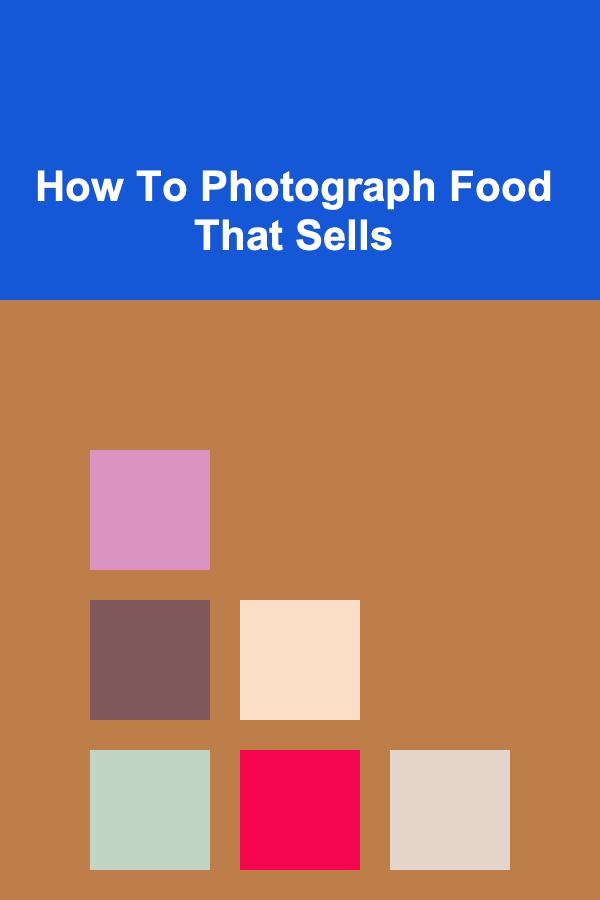
How To Photograph Food That Sells
ebook include PDF & Audio bundle (Micro Guide)
$12.99$5.99
Limited Time Offer! Order within the next:

In a world dominated by social media and digital marketing, food photography has become a crucial skill for anyone in the food industry, from restaurateurs to bloggers and social media influencers. A compelling food photograph can do wonders in attracting customers, increasing engagement, and boosting sales. But, how do you make food look so irresistible that it sells itself through a photograph?
This article will delve into the essential aspects of food photography, from understanding the basics of composition to mastering the use of lighting, props, and editing. We'll also discuss some advanced techniques to elevate your food photography game, ensuring that your images stand out in a crowded online marketplace.
Understanding the Power of Food Photography
Before diving into the technical aspects, it's crucial to understand why food photography is so important. In the food business, the visual appeal of your product often comes before the taste. A well-composed, high-quality image can:
- Increase online engagement: People are more likely to engage with visually appealing food photos on social media platforms like Instagram, Pinterest, or Facebook.
- Boost sales: A great food photograph can entice customers to purchase your dish, even if they have never tried it before.
- Build brand identity: Consistent, high-quality food photos contribute to a brand's overall image and can help set you apart from competitors.
- Establish trust: Professional-looking photos convey professionalism and attention to detail, making customers more likely to trust your business.
As a result, food photography has evolved into a form of visual storytelling, where you use images to evoke emotions, cravings, and experiences. Let's break down the steps involved in crafting food photos that not only look good but also convert into sales.
Key Principles of Effective Food Photography
Composition
Composition is the foundation of any good photograph. It refers to how elements are arranged in the frame to draw the viewer's eye and communicate the right message. The rule of thirds is a fundamental guideline in composition, where you divide your frame into a 3x3 grid and position key elements along these lines or at their intersections.
For food photography, composition also means considering how the food sits on the plate, how textures interact, and how various ingredients relate to one another within the frame. Here are some tips:
- Fill the frame: Don't be afraid to get close to the food and capture its textures in detail.
- Lead the eye: Use elements like cutlery or garnishes to lead the viewer's eye through the photograph.
- Balance your shot: Make sure the food is the focal point but don't neglect the surrounding environment. Every item in the frame should contribute to the story you're telling.
- Negative space: This is the empty space around the food. Using negative space effectively can make the food stand out and create a minimalist, elegant look.
Lighting
Lighting is one of the most critical elements in food photography. It has the power to elevate a photograph from ordinary to extraordinary by highlighting textures, colors, and details. Here's how to get lighting right:
- Natural light is your best friend: Whenever possible, shoot in natural light. It's soft, flattering, and brings out the colors in the food. Avoid harsh overhead lighting, which can create unappealing shadows.
- Diffuse the light: If the light is too harsh, use a diffuser to soften it. A simple white sheet or curtain can work wonders in creating a diffused, even light that is perfect for food photography.
- Use side or window light: Position the food near a window or shoot in the direction of natural light. Side lighting works particularly well for showcasing texture and adding depth to your images.
- Avoid direct flash: Flash can make the food look unnatural and unappealing. If you must use it, diffuse it or bounce it off a surface to soften the effect.
Styling and Props
Food styling is an art in itself. You need to ensure that the dish looks its best on camera, and this involves more than just placing the food on a plate. Here's how to style food for photos:
- Keep it simple: Use simple, clean plates that won't distract from the food. White or neutral-colored dishes often work best to allow the food to pop.
- Garnish thoughtfully: Garnishes should enhance the dish without overwhelming it. A sprig of herbs, a sprinkle of seeds, or a drizzle of sauce can elevate a dish's visual appeal.
- Use textures: Adding textures such as cloth napkins, wooden surfaces, or vintage plates can make the image feel more dynamic and natural. These props should complement, not overpower, the food.
- Consider the context: Show the food in its intended environment. For example, a bowl of soup might look great next to a rustic wooden spoon or a sandwich might be perfectly paired with a cup of coffee.
Color Theory
Colors play a huge role in making food look appetizing. The right colors can evoke a feeling of warmth, freshness, or indulgence, while poor color choices can make a dish look unappetizing. Consider the following when choosing your color palette:
- Complementary colors: Choose colors that complement each other, like green and red, or yellow and purple. This creates a visual harmony that makes the food more attractive.
- Contrast is key: Use contrasting colors to make the dish pop. For example, a rich brown sauce looks stunning against a creamy white plate or a vibrant green salad contrasts beautifully with a golden brown burger.
- Avoid overpowering colors: While color is important, don't let it overpower the food itself. Keep the background neutral or muted to make the food the main attraction.
Advanced Techniques to Enhance Your Food Photography
Once you've mastered the basics, you can move on to more advanced techniques to refine your food photography and make your images even more engaging.
1. Focus Stacking
Focus stacking is a technique where multiple images of the same subject are taken at different focal points and then combined in post-production. This allows you to achieve a greater depth of field, ensuring that the entire dish is in sharp focus, from the front to the back. This is particularly useful when shooting food with lots of textures, like layered cakes or bowls of pasta.
2. Use of Reflections
Reflections can add a sleek and modern touch to food photography. A shiny surface, like a glass table, can reflect light and make the food appear even more polished. Be mindful of the angle at which you shoot to ensure the reflection complements the food and doesn't distract from it.
3. Motion Blur
In some cases, adding a touch of motion to your food photography can make the image feel dynamic and exciting. For instance, capturing the moment when a spoon dips into a bowl of soup or when steam rises from a freshly baked dish can convey a sense of action and immediacy.
4. Tilt-Shift Photography
Tilt-shift photography creates a miniaturizing effect, making the food look like a tiny, detailed model. This effect is achieved by using a special lens or post-processing techniques. While not suitable for all types of food photography, it can add a unique touch to certain shots.
Editing Your Food Photos
Editing is the final step in the process that can take a good food photograph and turn it into a great one. While it's important to capture the image well in the camera, editing allows you to enhance colors, sharpen details, and create the perfect look. Here are some essential editing tips:
- Adjust exposure: Brighten the image slightly if it's too dark, or lower the exposure if the photo is overexposed.
- Enhance colors: Use the saturation and vibrancy tools to make the colors in your food pop, but be careful not to overdo it.
- Sharpen details: Subtle sharpening can help bring out the textures in your food, making it look even more inviting.
- Correct white balance: Sometimes food photos can have a color cast, especially under artificial lighting. Adjusting the white balance will help bring the food's true colors to life.
- Remove distractions: Use the cloning or healing tool to remove any unwanted elements from the background or around the dish.
Optimizing Food Photos for Marketing
Once you have stunning food photos, it's essential to optimize them for your intended platform. High-quality food images on social media, websites, or menus can attract attention and drive sales, but they need to be optimized for the web to ensure fast loading times and proper display.
- Resize images: Large image files can slow down website performance, so it's important to resize your photos to appropriate dimensions for each platform.
- Use the right file format: JPEG is a good choice for food photography as it offers a good balance between quality and file size. For photos with transparency (like product shots with a white background), use PNG.
- Add alt text: In addition to being important for SEO, alt text helps visually impaired users understand what the image represents. Use descriptive, keyword-rich alt text to improve your search engine ranking.
Conclusion
Food photography is a powerful tool in marketing that can elevate your brand, attract customers, and boost sales. By understanding the core principles of composition, lighting, styling, and color theory, you can create stunning food images that not only look beautiful but also encourage people to make a purchase.
Incorporating advanced techniques like focus stacking, motion blur, or reflections will further enhance your photography skills and set your images apart from the competition. And, don't forget the power of editing to refine your images and make them even more mouthwatering.
Mastering the art of food photography takes time, practice, and experimentation, but once you've honed your skills, you'll be able to create images that not only look great but also sell.

Effective Strategies for Minimizing Credit Card Debt and Regaining Financial Freedom
Read More
How to Build Wealth Early in Your Career for Long-Term Success
Read More
How to Make Money Online as a Remote Accountant: 10 Actionable Ideas
Read More
How To Play Legacy Games Without Spoilers
Read More
How To Use Social Apps for Meeting People
Read More
How To Pick the Perfect Horror Novel for a Chilling Read
Read MoreOther Products

Effective Strategies for Minimizing Credit Card Debt and Regaining Financial Freedom
Read More
How to Build Wealth Early in Your Career for Long-Term Success
Read More
How to Make Money Online as a Remote Accountant: 10 Actionable Ideas
Read More
How To Play Legacy Games Without Spoilers
Read More
How To Use Social Apps for Meeting People
Read More